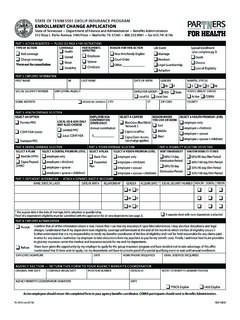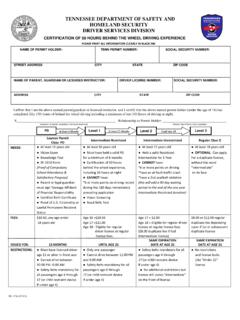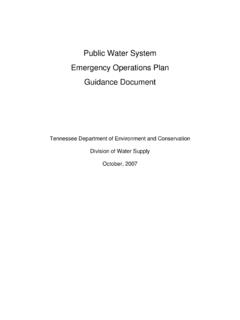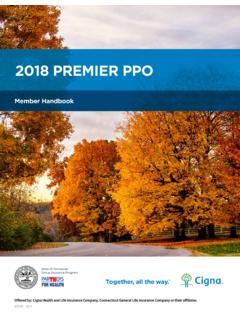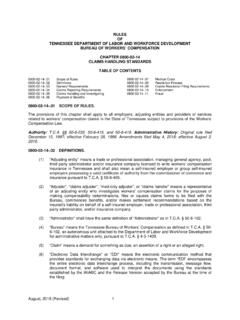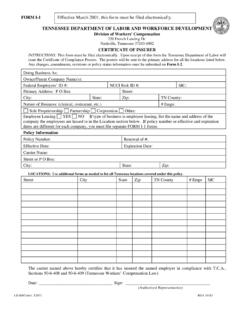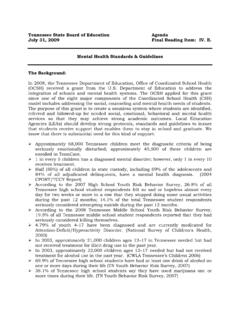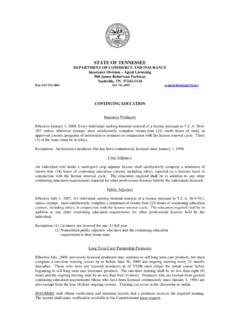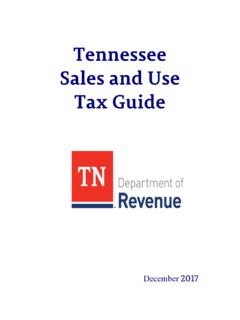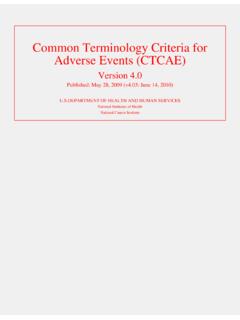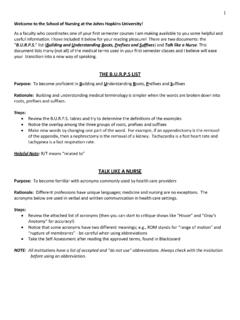Transcription of TENNESSEE EMERGENCY MEDICAL SERVICES PROTOCOL …
1 TENNESSEE EMERGENCY MEDICAL SERVICES PROTOCOL GUIDELINES Revised July 2017 Index Index Introduction Definitions MEDICAL Director s Statement Cardiac EMERGENCY (Adult & Pediatric) 101 Automatic External Defibrillator 102 New Onset Atrial Fibrillation and Flutter 103 Bradycardia 104 acute coronary syndrome /STEMI 105 chest pain / NON Cardiac 106 Pulseless Electrical Activity (PEA) 107 Premature Ventricular Contractions (PVC) 108 Supraventricular Tachycardia (SVT) 109 Torsades de Pointes 110 Ventricular Asystole 111 Ventricular Fibrillation / Pulseless Vent Tachycardia 112 Persistent Ventricular Fibrillation 113 Ventricular Tachycardia with a Pulse 114 Post Resuscitation Environmental EMERGENCY (Adult & Pediatric) 201 Chemical Exposure 202 Drug Ingestion 203 Electrocution / Lightning Injuries 204 Hyperthermia 205 Hypothermia 206 Near Drowning 207 Nerve Agents 208 Poisonous Snake Bite 209 Radiation / Hazmat MEDICAL EMERGENCY (Adult & Pediatric)
2 300 MEDICAL Complaint Not Specified Under Other Protocols 301 Abdominal pain Complaints (Non Traumatic) 302 acute Pulmonary Edema 303 Anaphylactic Shock 304 Cerebrovascular Accident (CVA) REFERENCE C-STAT Stroke Assessment Tool REFERENCE Pre-Hospital Screen for Thrombolytic Therapy 305 Croup 306 Family Violence 307 Hyperglycemia Associated with Diabetes 308 Hypertensive Crisis 309 Hypoglycemia 310 Medications at Schools 311 Non Formulary Medications 312 Respiratory Distress (Asthma/COPD) TENNESSEE EMERGENCY MEDICAL SERVICES PROTOCOL GUIDELINES Revised July 2017 Index Index Continued 313 Seizures 314 Sexual Assault 315 Sickle Cell Anemia 316 Unconscious / Unresponsive / Altered Mental Status 317 Syncope Shock / Trauma (Adult & Pediatric)
3 401 Air Ambulance Transport 402 Abdominal / Pelvic Trauma 403 Avulsed Teeth 404 Cardiogenic Shock 405 Eye Trauma 406 Hypovolemic Shock 407 Major Thermal Burn 408 Musculoskeletal Trauma 409 Multi-System Trauma 410 Neurogenic Shock 411 Septic Shock 412 Soft Tissue Trauma / Crush Injuries 413 Spinal Cord Injuries 414 Traumatic Cardiac Arrest 415 Traumatic Tension Pneumothorax 416 Traumatic Amputation(s) Obstetrical Emergencies REFERENCE APGAR Scoring 500 Obstetric / Gynecological Complaints (Non Delivery) 501 Normal Delivery / Considerations 502 Abruptio Placenta 503 Amniotic Sac Presentation 504 Breech or Limb Presentation 505 Meconium Stain 506 Placenta Previa 507 Prolapsed Umbilical Cord 508 Pre-eclampsia and Eclampsia Miscellaneous 601 Discontinuation / Withholding of Life Support 602 Field Determination of Death 603 Mandatory EKG 604 Patient Refusal of Care / No Patient Transport Situation REFERENCE Mini Mental Status Exam 605 Physical Restraint 606 Physician on the Scene 607 By-Stander on the Scene 608 Procedure for Deviation from Protocols 609 Spinal
4 Immobilization 610 Stretcher Transport TENNESSEE EMERGENCY MEDICAL SERVICES PROTOCOL GUIDELINES Revised July 2017 Index 611 Terminally Ill Patients Index Continued 612 Excited Delirium / Taser Use Pediatric Cardiac EMERGENCY 613 Neonatal Resuscitation Procedures PROCEDURE Capnography PROCEDURE chest Decompression PROCEDURE Continuous Positive Airway Pressure PROCEDURE Delayed Off Load of Stable Patients PROCEDURE Endotracheal Tube Introducer (Bougie) PROCEDURE External Transcutaneous Cardiac Pacing PROCEDURE Fever / Infection Control PROCEDURE Hemorrhage Control Clamp PROCEDURE Induced Hypothermia Following ROSC PROCEDURE Indwelling IV Port Access PROCEDURE Intranasal Medication Administration PROCEDURE IntraOsseous Access PROCEDURE Mechanical CPR PROCEDURE ResQPod PROCEDURE Tourniquet PROCEDURE Vascular Access Reference REFERENCE Consent Issues REFERENCE Patient Assessment Flow Chart REFERENCE Pulse Oximetry REFERENCE QI Documentation Criteria REFERENCE Sepsis Identification Tool REFERENCE Triage REFERENCE Trauma
5 Assessment / Destination Guidelines REFERENCE Trauma Treatment Priorities REFERENCE Trauma Score REFERENCE Glasgow Coma Scale REFERENCE Triage Decision Scheme REFERENCE Common MEDICAL Abbreviations Pharmacology REFERENCE Medication Dosage REFERENCE Drug Infusion Admix Dosage Guidelines Pediatric REFERENCE Pediatric Points to Remember REFERENCE Trauma Score REFERENCE Triage Decision Scheme REFERENCE Age, Weight, and Vitals Chart REFERENCE Age and Weight Related Equipment Guidelines TENNESSEE EMERGENCY MEDICAL SERVICES PROTOCOL GUIDELINES Revised July 2017 Index MEDICAL Director s Authorization TENNESSEE EMERGENCY MEDICAL SERVICES PROTOCOL GUIDELINES Revised July 2017 Introduction Introduction These PROTOCOL guidelines are provided by State of TENNESSEE Office of EMERGENCY MEDICAL SERVICES and are designed to be used as written or as a guideline for EMERGENCY MEDICAL Directors of Licensed EMERGENCY MEDICAL SERVICES in TENNESSEE .
6 Protocols provide direction for EMERGENCY MEDICAL SERVICES Personnel to render appropriate care for the sick and injured of all ages. It is recommended that SERVICES require EMS Personnel to familiarize themselves with the service approved Protocols and show successful completion by written documentation of competency in the Service Protocols to the Service MEDICAL Director. Administrative Notes: 1. The EMT and Advanced EMT (AEMT) will assist ALS personnel as requested and/or needed. 2. The EMERGENCY MEDICAL Responder will function under the current guidelines as stated in the AHA-BLS Healthcare Provider text.
7 Shall also be responsible for other duties as assigned within their Scope of Practice by the AEMT or the Paramedic. 3. Providers currently licensed as AEMT will continue to function at their current scope of practice until the appropriate bridge certification has been obtained through a state accredited program. 4. The Paramedic will be in charge and will be responsible for all of the actions and or activities as it relates to the EMERGENCY Unit. On the scene of an EMERGENCY , the Paramedic will be responsible for patient care. The EMT or AEMT will act within their scope of practice to any re quest for patient care or maintenance of the unit as directed by the Paramedic.
8 Patient care is limited to acts within their scope of practice as defined by these SOPs. The EMS Personnel are responsible for reviewing all documentation and signing in the required manner 5. It is the responsibility of the most qualified Paramedic caring for the patient to ensure transmission of all aspects of the patient assessment and care to the responding EMERGENCY Unit or MEDICAL Control. 6. When reporting a disposition to MEDICAL Control or the responding unit, provide the following minimum information: a. Patient s age and chief complaint b. Is the patient stable or unstable, including complete V/S and LOC c.
9 Interventions performed d. Provide other information as requested. 7. For each and every call, the first directives are scene safety and body substance isolation precautions. 8. For any drug administration of procedures outside these Guidelines, the EMS Provider must receive authorization from MEDICAL Control. Paramedics en-route to the scene are not authorized to issue orders. 9. The minimal equipment required for all patient calls: a. When the patient is in close proximity to the unit or EMERGENCY MEDICAL Responder: jump bag, cardiac monitor, and oxygen or other equipment as may be indicated by the nature of the call TENNESSEE EMERGENCY MEDICAL SERVICES PROTOCOL GUIDELINES Revised July 2017 Introduction b.
10 When the patient is not in close proximity of the unit or EMERGENCY MEDICAL Responder: the above equipment, stretcher and any other equipment that may be needed as dictated by the nature of the call. 10. The senior Paramedic has the ultimate responsibility to ensure that all records and reports are properly completed. The patient care report should accurately reflect the clinical activities undertaken. If there is a patient refusal, declination, or dismissal of service at the scene of the incident, the incident report should reflect the details as well as the party or parties responsible for the request to terminate any and all evaluations and treatment.
